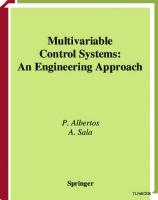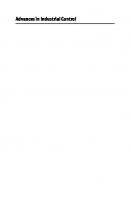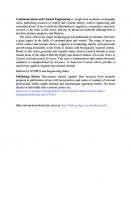Control Engineering Solutions: A Practical Approach 0852968299, 9780852968291
This unusual book addresses a number of common control problems from an experimental engineering perspective, using low-
399 22 237KB
English Pages xxii+298 [322] Year 1997
Table of contents :
Control Engineering Solutions: A Practical Approach......Page 4
Contents......Page 6
Preface......Page 14
Introduction......Page 16
Contributors......Page 22
1.2 Control problem......Page 24
1.3 Technical approaches......Page 27
1.4 Discussion and laboratory experience......Page 29
1.4.2 Sampling period selection......Page 30
1.4.3 Data conditioning......Page 31
1.4.4 Model structure selection......Page 33
1.4.5 Signal excitability......Page 37
1.4.6 Parameter tracking and forgetting factors......Page 38
1.4.7 Closed loop identification......Page 41
1.5 Conclusions......Page 42
1.6 References......Page 43
1.7 Appendix: Process physico-chemical behaviour laws......Page 44
2.2 Motivation......Page 46
2.3.1 Design of single loop control......Page 47
2.5.3 Two-variable control......Page 48
2.3.4 Two- and three-level control......Page 52
2.4 Laboratory set-up (simulation tools)......Page 54
2.5 Suggested experiments and problems......Page 57
2.6.2 Two-variable control......Page 61
2.7 Conclusions......Page 64
2.8 References......Page 65
3.2 Control problem (motivation)......Page 66
3.3 Technical approaches to classic regulator design......Page 70
3.3.2 Analytical methods......Page 71
3.3.3 Controller design based on rule-of-thumb methods......Page 73
3.5 Controller simulation software......Page 74
3.6 Suggested experiments......Page 80
3.7 Illustrative results......Page 81
3.9 References......Page 82
4.1 Introduction......Page 84
4.2 Motivation and control problem statement......Page 85
4.3.1 Reset wind-up occurrence in PI controllers of different construction......Page 86
4.3.2 Anti-wind-up measures......Page 88
4.3.4 Incremental PID algorithm for practical applications......Page 89
4.5 Laboratory set-up and simulation model for wind-up investigation......Page 91
4.5.1 Integration stopping in simulation models......Page 92
4.6 Suggested experiments......Page 94
4.7.1 Results from set-up measurement......Page 95
4.7.2 Results from simulation......Page 96
4.9 References......Page 98
4.10 Other reading......Page 99
5.2 Motivation (control problem)......Page 100
5.2.1 Design limitations......Page 101
5.2.3 Control problem......Page 102
5.3 Technical approaches to the control of unstable processes......Page 105
5.3.2 State controller with observer......Page 106
5.4 Discussion......Page 107
5.5 Laboratory set-up......Page 109
5.7.1 Linear quadratic regulator......Page 110
5.7.4 The optimised PID using a GA approach......Page 111
5.8 Conclusions......Page 114
5.10 References......Page 116
6.2 Control problem statement......Page 120
6.2.2 Control problem example......Page 122
6.3 Process model analysis......Page 123
6.4.1 Technical approach and discussion......Page 125
6.4.3 State feedback control arrangement......Page 126
6.5 Controller parameter assignment......Page 127
6.5.1 PID controller setting assignment......Page 128
6.5.2 State feedback parameter assignment......Page 131
6.6 Suggested experiments......Page 132
6.8 References......Page 133
6.9 Further reading......Page 134
7.2 Theoretical foundations......Page 136
7.3 The 'inverted pendulum' system......Page 138
7.3.1 Mathematical model of the inverted pendulum......Page 139
7.3.2 Description of the linearised system in the state space......Page 140
7.3.3 Normalisation of the state equations......Page 142
7.3.4 Control and disturbance signal observation in the 'inverted pendulum'......Page 143
7.4 Suggested experiments......Page 146
7.5 Illustrative results......Page 147
7.7 References......Page 151
8.2 Control problem......Page 152
8.3 Technical background......Page 154
8.3.1 Disturbance filtering......Page 156
8.3.2 Disturbance estimation......Page 157
8.4.1 Model......Page 159
8.5.1 Basic controller......Page 160
8.5.2 Feedback filter......Page 162
8.5.3 Disturbance estimator......Page 164
8.7 Conclusions......Page 167
8.8 References......Page 169
9.1 Introduction to multivariable systems......Page 170
9.2.1 Laboratory process: motor-alternator set......Page 171
9.2.2 Model identification tests......Page 172
9.3.1 Non-interacting control......Page 174
9.3.2 The characteristic locus method......Page 176
9.4.1 Implementation of a digital compensator for the motor-alternator......Page 181
9.4.2 An alternative multivariable process......Page 182
9.5 Summary......Page 183
9.6 References......Page 184
10.2 Control problem......Page 186
10.3.1 PID algorithm......Page 187
10.3.2 Predictive algorithm......Page 188
10.5 Laboratory set-up......Page 190
10.6 Suggested experiments......Page 191
10.7 Illustrative examples......Page 193
10.9 References......Page 197
11.1 Introduction......Page 198
11.2 Models of piston movements in a pneumatic cylinder......Page 199
11.3 Adaptive control system for a pneumatic cylinder......Page 202
11.3.1 State reconstruction......Page 203
11.3.2 State space control algorithm......Page 204
11.3.3 Model parameter estimation......Page 205
11.3.4 Compensation of valve nonlinearity......Page 206
11.5 Laboratory equipment......Page 207
11.6 Experimental scope......Page 208
11.7 Conclusions......Page 212
11.9 References......Page 213
12.2 Motivation......Page 216
12.3 Technical approaches to distributed process control......Page 218
12.4 Discussion......Page 219
12.4.1 Distributed control......Page 220
12.4.2 Boundary control......Page 222
12.5.1 For distributed control......Page 224
12.5.2 For boundary control......Page 225
12.6 Suggested experiments......Page 226
12.7 Illustrative results......Page 227
12.8 Conclusions......Page 229
12.9 References......Page 231
13.2.1 Fuzzy operators......Page 232
13.3.1 Fuzzy controller for a steam turbine......Page 234
13.3.3 Fuzzy controller for the inverted pendulum......Page 236
13.4 Discussion......Page 238
13.6 Suggested experiments......Page 241
13.7 Illustrative results......Page 242
13.8 Conclusion......Page 243
13.9 References......Page 244
14.1 Control problem......Page 246
14.2.1 Supervision tasks......Page 248
14.2.2 Selection of indicators for supervision......Page 251
14.2.3 Functions and tasks of the supervisory level......Page 255
14.2.4 Implementation of supervision functions......Page 257
14.3 Laboratory set-up......Page 258
14.4.2 Estimator scheduling......Page 261
14.6 References......Page 263
14.7.1 Associated with the pre-identification process......Page 264
14.7.2 Associated with the estimation process......Page 265
14.7.3 Associated with the controller computation......Page 267
14.7.4 Associated with the closed loop......Page 268
15.2 Problem formulation......Page 270
15.3 Process and fault model......Page 271
15.4 Robust fault detection......Page 272
15.6 Design of fault detection filters for a three tank system......Page 273
15.8 References......Page 282
16.2 Control problem......Page 284
16.3.1 Cascade configuration......Page 285
16.3.2 Parallel configuration......Page 287
16.5 Laboratory set-up......Page 289
16.7 Illustrative results......Page 290
16.8 Conclusions......Page 292
16.9 References......Page 293
17.2 Motivation......Page 296
17.5 Laboratory set-up......Page 298
17.6 Suggested experiments......Page 300
17.7 Illustrative results......Page 303
17.8 Conclusions......Page 307
17.9 References......Page 309
Index......Page 310
Control Engineering Solutions: A Practical Approach......Page 4
Contents......Page 6
Preface......Page 14
Introduction......Page 16
Contributors......Page 22
1.2 Control problem......Page 24
1.3 Technical approaches......Page 27
1.4 Discussion and laboratory experience......Page 29
1.4.2 Sampling period selection......Page 30
1.4.3 Data conditioning......Page 31
1.4.4 Model structure selection......Page 33
1.4.5 Signal excitability......Page 37
1.4.6 Parameter tracking and forgetting factors......Page 38
1.4.7 Closed loop identification......Page 41
1.5 Conclusions......Page 42
1.6 References......Page 43
1.7 Appendix: Process physico-chemical behaviour laws......Page 44
2.2 Motivation......Page 46
2.3.1 Design of single loop control......Page 47
2.5.3 Two-variable control......Page 48
2.3.4 Two- and three-level control......Page 52
2.4 Laboratory set-up (simulation tools)......Page 54
2.5 Suggested experiments and problems......Page 57
2.6.2 Two-variable control......Page 61
2.7 Conclusions......Page 64
2.8 References......Page 65
3.2 Control problem (motivation)......Page 66
3.3 Technical approaches to classic regulator design......Page 70
3.3.2 Analytical methods......Page 71
3.3.3 Controller design based on rule-of-thumb methods......Page 73
3.5 Controller simulation software......Page 74
3.6 Suggested experiments......Page 80
3.7 Illustrative results......Page 81
3.9 References......Page 82
4.1 Introduction......Page 84
4.2 Motivation and control problem statement......Page 85
4.3.1 Reset wind-up occurrence in PI controllers of different construction......Page 86
4.3.2 Anti-wind-up measures......Page 88
4.3.4 Incremental PID algorithm for practical applications......Page 89
4.5 Laboratory set-up and simulation model for wind-up investigation......Page 91
4.5.1 Integration stopping in simulation models......Page 92
4.6 Suggested experiments......Page 94
4.7.1 Results from set-up measurement......Page 95
4.7.2 Results from simulation......Page 96
4.9 References......Page 98
4.10 Other reading......Page 99
5.2 Motivation (control problem)......Page 100
5.2.1 Design limitations......Page 101
5.2.3 Control problem......Page 102
5.3 Technical approaches to the control of unstable processes......Page 105
5.3.2 State controller with observer......Page 106
5.4 Discussion......Page 107
5.5 Laboratory set-up......Page 109
5.7.1 Linear quadratic regulator......Page 110
5.7.4 The optimised PID using a GA approach......Page 111
5.8 Conclusions......Page 114
5.10 References......Page 116
6.2 Control problem statement......Page 120
6.2.2 Control problem example......Page 122
6.3 Process model analysis......Page 123
6.4.1 Technical approach and discussion......Page 125
6.4.3 State feedback control arrangement......Page 126
6.5 Controller parameter assignment......Page 127
6.5.1 PID controller setting assignment......Page 128
6.5.2 State feedback parameter assignment......Page 131
6.6 Suggested experiments......Page 132
6.8 References......Page 133
6.9 Further reading......Page 134
7.2 Theoretical foundations......Page 136
7.3 The 'inverted pendulum' system......Page 138
7.3.1 Mathematical model of the inverted pendulum......Page 139
7.3.2 Description of the linearised system in the state space......Page 140
7.3.3 Normalisation of the state equations......Page 142
7.3.4 Control and disturbance signal observation in the 'inverted pendulum'......Page 143
7.4 Suggested experiments......Page 146
7.5 Illustrative results......Page 147
7.7 References......Page 151
8.2 Control problem......Page 152
8.3 Technical background......Page 154
8.3.1 Disturbance filtering......Page 156
8.3.2 Disturbance estimation......Page 157
8.4.1 Model......Page 159
8.5.1 Basic controller......Page 160
8.5.2 Feedback filter......Page 162
8.5.3 Disturbance estimator......Page 164
8.7 Conclusions......Page 167
8.8 References......Page 169
9.1 Introduction to multivariable systems......Page 170
9.2.1 Laboratory process: motor-alternator set......Page 171
9.2.2 Model identification tests......Page 172
9.3.1 Non-interacting control......Page 174
9.3.2 The characteristic locus method......Page 176
9.4.1 Implementation of a digital compensator for the motor-alternator......Page 181
9.4.2 An alternative multivariable process......Page 182
9.5 Summary......Page 183
9.6 References......Page 184
10.2 Control problem......Page 186
10.3.1 PID algorithm......Page 187
10.3.2 Predictive algorithm......Page 188
10.5 Laboratory set-up......Page 190
10.6 Suggested experiments......Page 191
10.7 Illustrative examples......Page 193
10.9 References......Page 197
11.1 Introduction......Page 198
11.2 Models of piston movements in a pneumatic cylinder......Page 199
11.3 Adaptive control system for a pneumatic cylinder......Page 202
11.3.1 State reconstruction......Page 203
11.3.2 State space control algorithm......Page 204
11.3.3 Model parameter estimation......Page 205
11.3.4 Compensation of valve nonlinearity......Page 206
11.5 Laboratory equipment......Page 207
11.6 Experimental scope......Page 208
11.7 Conclusions......Page 212
11.9 References......Page 213
12.2 Motivation......Page 216
12.3 Technical approaches to distributed process control......Page 218
12.4 Discussion......Page 219
12.4.1 Distributed control......Page 220
12.4.2 Boundary control......Page 222
12.5.1 For distributed control......Page 224
12.5.2 For boundary control......Page 225
12.6 Suggested experiments......Page 226
12.7 Illustrative results......Page 227
12.8 Conclusions......Page 229
12.9 References......Page 231
13.2.1 Fuzzy operators......Page 232
13.3.1 Fuzzy controller for a steam turbine......Page 234
13.3.3 Fuzzy controller for the inverted pendulum......Page 236
13.4 Discussion......Page 238
13.6 Suggested experiments......Page 241
13.7 Illustrative results......Page 242
13.8 Conclusion......Page 243
13.9 References......Page 244
14.1 Control problem......Page 246
14.2.1 Supervision tasks......Page 248
14.2.2 Selection of indicators for supervision......Page 251
14.2.3 Functions and tasks of the supervisory level......Page 255
14.2.4 Implementation of supervision functions......Page 257
14.3 Laboratory set-up......Page 258
14.4.2 Estimator scheduling......Page 261
14.6 References......Page 263
14.7.1 Associated with the pre-identification process......Page 264
14.7.2 Associated with the estimation process......Page 265
14.7.3 Associated with the controller computation......Page 267
14.7.4 Associated with the closed loop......Page 268
15.2 Problem formulation......Page 270
15.3 Process and fault model......Page 271
15.4 Robust fault detection......Page 272
15.6 Design of fault detection filters for a three tank system......Page 273
15.8 References......Page 282
16.2 Control problem......Page 284
16.3.1 Cascade configuration......Page 285
16.3.2 Parallel configuration......Page 287
16.5 Laboratory set-up......Page 289
16.7 Illustrative results......Page 290
16.8 Conclusions......Page 292
16.9 References......Page 293
17.2 Motivation......Page 296
17.5 Laboratory set-up......Page 298
17.6 Suggested experiments......Page 300
17.7 Illustrative results......Page 303
17.8 Conclusions......Page 307
17.9 References......Page 309
Index......Page 310



![Process Control: A Practical Approach [1 ed.]
0470975873, 9780470975879](https://ebin.pub/img/200x200/process-control-a-practical-approach-1nbsped-0470975873-9780470975879.jpg)




![Salmonella: A Practical Approach to the Organism and its Control in Foods [1 ed.]
0632055197](https://ebin.pub/img/200x200/salmonella-a-practical-approach-to-the-organism-and-its-control-in-foods-1nbsped-0632055197.jpg)

![A Practical Approach to Motor Vehicle Engineering and Maintenance, Third Edition [3rd ed.]
0080969984, 9780080969985](https://ebin.pub/img/200x200/a-practical-approach-to-motor-vehicle-engineering-and-maintenance-third-edition-3rdnbsped-0080969984-9780080969985.jpg)